- Home
- Technical Cooperation Projects
- Index of Countries
- Middle East
- Egypt
- Project for Strengthening Water Management Transfer
- Project News
- Training Course on Participatory Water Management in Japan was successfully implemented.
Project News
2015-02-08
Training Course on Participatory Water Management in Japan was successfully implemented.
The Project for Strengthening Water Management Transfer (SWMT Project) implemented the Second Training Course on Participatory Water Management in Japan in the period from November 29 to December 14, 2014.
In this training, there were 13 participants including the counterparts (CPs) and a chairman of Branch Canal Water Users' Associations (BCWUAs) in the pilot site accompanied by Eng. Yutaka Inoue, one of JICA Project's Experts. They visited the Ministry of Agriculture, Forestry and Fisheries (MAFF) of Japan, Land Improvement Districts (LID) of Ryoso in Chiba Prefecture and Department of Toyogawa River System of Japan Water Agency.
In the MAFF as their first destination, as the participants had lectures on activities of land improvement and operation and maintenance of water facilities as well as on LIDs, they showed great interests in those topics and asked various questions about them.
In the LID of Ryoso, the participants received lectures on the activities, organization and roles of the LID, while they actually visited the major facilities. It was useful for the participants to watch a short movie which displayed the history and the structure of the LID because it gave them a clear image about those matters before visiting the LIDs' offices.
In visiting a local farmer there, they firstly visited Mr. Hayashi, Town Mayor at the Shirako Town Council, and had briefing on farmers' activities by the Farmers' Association on Shipment of Onions. Through discussion, it became clear to the participants that the Farmers' Association in Japan were established by farmers themselves, whereas in Egypt it seems that Agricultural Cooperatives are still established with the initiatives of the government.
Moreover, the participants were very interested in the fact that the farmers could increase their individual incomes through their collective work as an association and making brands of their yields. Later on, they observed cultivation of tomatoes by water culture in which fertilizers are melted without using soils under automatic control by computers. Although it is actually difficult to do it in Egypt because of the high cost, it was very instructive for the participants to see such an effective and high technology of irrigation.
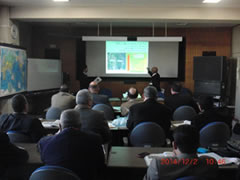 Training in the MAFF
Training in the MAFF
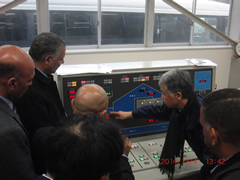 Manipulation board of a pump
Manipulation board of a pump
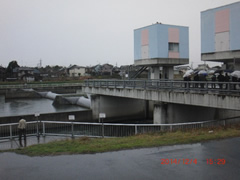 Yokoshiba Weir
Yokoshiba Weir
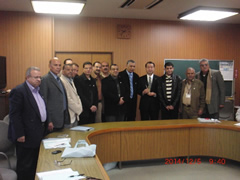 Visit at the Shirako Town Mayor
Visit at the Shirako Town Mayor
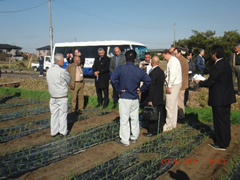 Farms of onions
Farms of onions
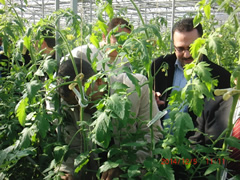 Cultivation of tomatoes by water culture
Cultivation of tomatoes by water culture
In the Department of Toyogawa River System, the participants had lectures on the project and the relationships with the relevant LIDs, and visited the major facilities. They showed their large interests in the main canal which was running at the middle of mountains as well as Manba Reservoir which is one of the largest reservoirs in the world whose bottoms are made of rubber. .
They were also surprised with the high speed of water flow in the canal that they don't normally see in Egypt, although it was normal for us (Note: Considering the canal is made of soils, 160 km long and has a difference of 16 m between the lowest and highest places in Egypt, while that canal there is made of cements, 80 km long and a difference of 60 m between the lowest and highest places, supposing that all the other conditions are the same in the two canals, the speed of water flow there is about 6 times as fast as the one in Egypt.). However, when they visited and saw the manipulation panels in the general operation room next to the Muromatsubara Weir, they could understand how the water of such high speed can be controlled.
In visiting a local famer there, the participants saw the cultivation of chrysanthemums in the plastic green houses. Since chrysanthemums are sold and seen in Egypt, they asked various questions about the cost, benefits and harvests to the farmer.
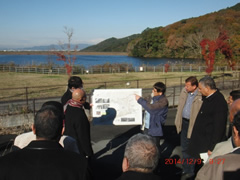 Explanation on Second Project of the Toyogawa River System
Explanation on Second Project of the Toyogawa River System
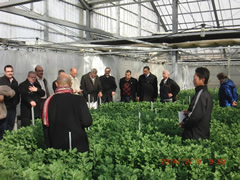 Visit at a famer cultivating chrysanthemums
Visit at a famer cultivating chrysanthemums
Finally, the participants went back to Tokyo and made presentations on how they are going to use the training outcomes in Egypt. Major points were as follows.
- It is necessary to enhance farmers' awareness, while the governmental staff also need to change their minds.
- It is necessary to reinforce partnerships among the Water Users' Organizations.
- Considering the Japanese law that Land Improvement Project can be implemented with consents by the relevant farmers of 2/3. Egypt also needs such law.
- To solve the problem of illegal water intake in Egypt, all stakeholders including the government, farmers and the WUOs must work together, referring to the LIDs in Japan.
In conclusion, the participants were actively and seriously participating in the whole training and hence we could have very good outcomes, while they are very satisfied with the training contents. Besides the training, they could enjoy their stay in Japan by going shopping in Akihabara and sightseeing in Asakusa on the weekends. We hope that they will effectively use those outcomes in their daily works after going back to Egypt.
Finally, we sincerely thank all of people who were involved in this training for their full support to all of us.
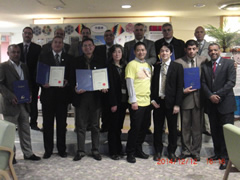 Group photo after the closing ceremony.
Group photo after the closing ceremony.
- About JICA
- News & Features
- Countries & Regions
- Our Work
- Thematic Issues
- Types of Assistance
- Partnerships with Other Development Partners
- Climate Change / Environmental and Social Considerations
- Evaluations
- Compliance and Anti-corruption
- Science and Technology Cooperation on Global Issues
- Research
- JICA Development Studies Program / JICA Chair
- Support for the Acceptance of Foreign HRs / Multicultural and Inclusive Community
- Publications
- Investor Relations
